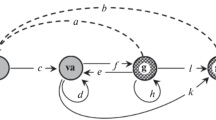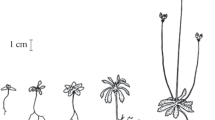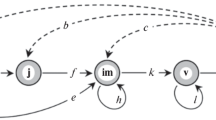Abstract
In the previous publication (Logofet et al., 2017), we reported on constructing a matrix model for a local population of Eritrichium caucasicum at high altitudes of north-western Caucasus. The model described the population structure according to the stages of ontogeny and field data for 6 years of observation. Calibrated from the data, the matrices, L(t), of stage-specific vital rates, which projected the population vector at time t (t = 2009, 2010, …, 2013) to the next year, were dependent on t and naturally different, reflecting indirectly the temporal differences in habitat conditions that occurred during the observations. Therefore, the model turned out to be non-autonomous. In addition to the range of variations in the adaptation measure λ1(L), we also obtained certain “age traits from a stage-structured model,” such as the average stage duration and the life expectancy for each stage. Those traits were uniquely determined for each given matrix L by a known (from the English literature) VAMC (virtual absorbing Markov chain) technique, while their variations for different years t pointed out the need to solve a mathematical problem of finding the geometric mean (G) of five matrices L(t) with a fixed pattern. The problem has no exact solution, whereas the best approximate one (presented here) results in the estimate of life expectancy as 3.5 years and that of the mean age at first flowering as 12 years. Given the data of 6-year observations, the forecast of whether the local population increases/declines in the long term draws on the range of possible variations in the measure λ1(G) under reproductive uncertainty, and this range localizes entirely to the right of 1, though very close to λ1 = 1 meaning a stable population.
Similar content being viewed by others
References
Caswell, H., Matrix Population Models: Construction, Analysis, and Interpretation, Sunderland, MA: Sinauer, 2001, 2nd ed.
Cochran, M.E. and Ellner, S., Simple methods for calculating age-based life history parameters for stage-structured populations, Ecol. Monogr., 1992, vol. 62, no. 3, pp. 3455–3464.
Cushing, J. M. and Yicang, Z., The net reproductive value and stability in matrix population models, Nat. Resour. Model., 1994, vol. 8, no. 4, pp. 297–333.
Dobronets, B.S., Interval’naya matematika (Interval Mathematics), Krasnoyarsk: Krasnoyarsk Gos. Univ., 2004.
Jorgensen, S.E. and Bendoricchio, G., Fundamentals of Ecological Modeling, Amsterdam: Elsevier, 2001, 3rd ed.
Kazatnseva, E.S., Population dynamics and seed production in alpine short-lived perennials of Northwestern Caucasus, Cand. Sci. (Biol.) Dissertation, Moscow: Moscow State Univ., 2016.
Kazatnseva, E.S., Onipchenko, V.G., and Kipkeev, A.M., Age at first flowering in alpine herbaceous short-lived perennials of North-Western Caucasus, Byull. Mosk. Ova. Ispyt. Prir., Otd. Biol., 2016a, vol. 121, no. 2, pp. 73–80.
Kazatnseva, E.S., Medvedev, V.G., and Onipchenko, V.G., Calculation of the ontogenetic stage duration in herbaceous plants by the example of Anthyllis vulneraria L, Ekol. Vestn. Sev. Kavk., 2016b, vol. 12, no. 2, pp. 18–26.
Kazatnseva, E.S., Medvedev, V.G., and Onipchenko, V.G., Population dynamics of alpine short-lived perennials, the duration of life and ontogenetic stages, Yug Ross.: Ekol., Razvit., 2016c, vol. 11, no. 2, pp. 95–107.
Kemeny, J.G. and Snell, J.L., Finite Markov Chains, Berlin: Springer-Verlag, 1976.
Keyfitz, N., Introduction to the Mathematics of Population, Reading, MA: Addison-Wesley, 1977.
Kipkeev, A.M., Onipchenko, V.G., Tekeev, D.K., Erkenova, M.A., and Salpagarova, F.S., Age of maturity in alpine herbaceous perennials in the North-West Caucasus, Biol. Bull. Rev., 2015, vol. 5, no. 5, pp. 505–511.
Li, C.-K. and Schneider, H., Application of Perron–Frobenius theory to population dynamics, J. Math. Biol., 2002, vol. 44, pp. 450–462.
Linnik, Yu.V., Metod naimen’shikh kvadratov i osnovy matematiko-statisticheskoi teorii obrabotki nablyudenii (Least Squares Method and Fundamentals of Mathematical-Statistical Theory of Data Processing), Moscow: Gos. Izd. Phys.-Mat. Lit., 1962, 2nd ed.
Logofet, D.O., Convexity in projection matrices: projection to a calibration problem, Ecol. Model., 2008, vol. 216, no. 2, pp. 217–228.
Logofet, D.O., Svirezhev’s substitution principle and matrix models for dynamics of populations with complex structures, Zh. Obshch. Biol., 2010, vol. 71, no. 1, pp. 30–40.
Logofet, D.O., Complexity in matrix population models: polyvariant ontogeny and reproductive uncertainty, Ecol. Complexity, 2013a, vol. 15, pp. 43–51.
Logofet, D.O., Projection matrices in variable environments: λ 1 in theory and practice, Ecol. Model., 2013b, vol. 251, pp. 307–311.
Logofet, D.O., Projection matrices revisited: a potential growth indicator and the merit of indication, J. Math. Sci., 2013c, vol. 193, no. 5, pp. 671–686.
Logofet, D.O. and Belova, I.N., Nonnegative matrices as a tool to model population dynamics: classical models and contemporary expansions, J. Math. Sci., 2008, vol. 155, no. 6, pp. 894–907.
Logofet, D.O., Ulanova, N.G., and Belova, I.N., Two paradigms in mathematical population biology: an attempt at synthesis, Biol. Bull. Rev., 2012, vol. 2, no. 1, pp. 89–104.
Logofet, D.O, Belova, I. N., Kazantseva, E. S., and Onipchenko, V. G., Local population of Eritrichium caucasicum as an object of mathematical modeling. I. Life cycle graph and a nonautonomous matrix model, Biol. Bull. Rev., 2017, vol. 7, no. 5, pp. 415–427.
MathWorks, Documentation. http://www.mathworks.com/help/optim/ug/fmincon.html?s_tid=srchtitle. Accessed December 14, 2017.
Onipchenko, V.G. and Komarov, A.S., Population dynamics and life history features of three alpine plant species in the Northwest Caucasus, Zh. Obshch. Biol., 1997, vol. 58, no. 6, pp. 64–75.
Popov, M.G., Family Boraginaceae, in Flora SSSR (Flora of the Soviet Union), Shishkin, B.K., Ed., Moscow: Akad. Nauk SSSR, 1953, vol. 19.
Results of the 2013 competition, Russian Foundation of Basic Research. http://www.rfbr.ru/rffi/ru/project_-search/o_1890907. Accessed December 14, 2017.
Tuljapurkar, S.D., Population Dynamics in Variable Environments, New York: Springer-Verlag, 1990.
Zhmylev, P.Yu., Alekseev, Yu.E., Karpukhina, E.A., and Balandin, S.A, Biomorfologiya rastenii: illustrirovannyi slovar’. Uchebnoe posobie (Biomorphology of Plants: Illustrated Dictionary. Manual), Moscow: Mosk. Gos. Univ., 2005, 2nd ed.
Author information
Authors and Affiliations
Corresponding author
Additional information
Original Russian Text © D.O. Logofet, E.S. Kazantseva, I.N. Belova, V.G. Onipchenko, 2017, published in Zhurnal Obshchei Biologii, 2017, Vol. 78, No. 1, pp. 56–66.
The article was translated by the authors.
Rights and permissions
About this article
Cite this article
Logofet, D.O., Kazantseva, E.S., Belova, I.N. et al. Local Population of Eritrichium caucasicum as an Object of Mathematical Modelling. II. How Short Does the Short-Lived Perennial Live?. Biol Bull Rev 8, 193–202 (2018). https://doi.org/10.1134/S2079086418030076
Received:
Published:
Issue Date:
DOI: https://doi.org/10.1134/S2079086418030076




